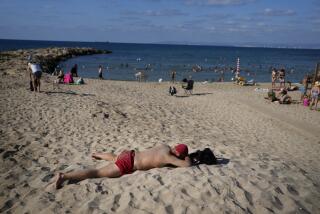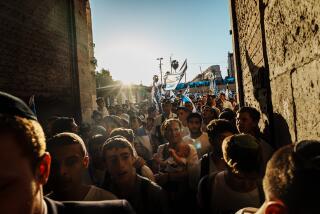Sunrise Lends a Whole New Perspective to Israel
- Share via
JERUSALEM — The early bird who rises at dawn before the tour buses start cranking their gears will capture the best of Israel.
Early morning is the best time for this city turning gold with the first rays of the sun: the sheep market at the old city’s Damascus Gate; the awakening of the Old City as viewed from atop its walls; the Bedouins’ Thursday morning market in Beersheva, and the serenity of Masada at daybreak.
Getting there is not always easy, however.
We were advised not to miss the weekly sheep market, but were stymied by the typical Israeli question/answer response to our quest for directions:
Question: “How do I get to the sheep market?”
Answer: “You want to take a sheep home?”
With persistence we found a convention of Arab men and boys assembled at the north sector of Turk Suleiman the Magnificent’s battlement wall, east of Herod’s Gate, opposite the Rockefeller museum on Suleiman Street.
Livestock for Sale
We arrived about 7 a.m., in time to watch sellers disgorge their bedraggled squealing and braying livestock--goats and sheep--from the rear of station wagons and the trunks of Mercedes taxis.
Bedouin men, tall and dignified in white keffiyehs (the traditional Arab headdress banded around the forehead with black rope), search out their intended purchase as they roam between clusters of animals lashed by rope to stakes pounded into the sandy ground.
Under their long, flowing white caftans they sport ties and black, pin-striped business suits.
Animals are appraised by a squeeze to their underbellies, and money afterward surreptitiously changes hands during heated, huddled discussions.
From the bleachers, a low brick wall surrounding the encampment, dark-robed men squat upon bent legs, placidly eyeing the proceedings while they finger worry beads.
The market also is a social event for their sons, youths in white robes and lacy skull caps who tug at well-fed brown goats and frolic with friends.
Refreshments are hawked from carts stacked with soft round bilalies (bagel-shaped breads topped with sprinkles of sesame seeds). An itinerant merchant serves hot tea from a brass samovar strapped to his back, rinsing the glasses in a bucket of water.
Another treat also begins at dawn when the deserted sleeping city shakes its lethargy. The exotic sounds and odors of the Middle East announce the start of a business day. From a walkway along the top of the adjacent battlements encircling old Jerusalem you can watch this daily ritual.
Begin around 6:30 a.m. at Damascus Gate in the north, and continue counter-clockwise to Dung Gate and the Ophel Garden excavations in the southeast.
The battlements, vestiges of Herodean, Byzantine, Crusader and Turkish additions, vary in height from about 30 to 60 feet. Holes in casements enable strollers, protected by black iron guide rails, to peer at views outside the walls.
As a muezzin from atop a minaret in the Muslim quarter chants his call to prayer, the city awakens with a cacophony of sounds complemented by aromas of freshly baked hot pita breads emerging from bakery ovens, and the exotic combinations of spices venting from just-opened shops.
Below, storekeepers languidly set up shop, ready to hawk vegetables. Veiled ladies, squatting in colorfully embroidered black dresses, chatter beside turquoise baskets of scallions and escarole.
A horse-drawn wagon laden with carrots clunks down the steps of a narrow cobbled street, forcing strollers to flatten against an adjacent building.
You can detour at many of the gates along the wall for rest stops, snack intermissions or exotic shopping.
Bedouin handicrafts from hammered copper pots, jewelry and rugs to intricately embroidered blouses are displayed for bargainers. Flaky golden baklava pastries are diamond sliced on round trays, and pyramids of spices and tobacco in gunny sacks are sold from scales balanced by stones.
But before starting on a hike through the old city, pocket a flask of water or a folding cup, for many juice bars offer fruit drinks from a communal cup.
Reaching other early morning destinations can become challenging. A cab driver offered us an early bargain rate up to the Mount of Olives to view the golden sunrise, then quadrupled his charge when we were ready to return.
The problem could have been averted if we had we negotiated a round-trip fare before starting out and paid it only upon completion.
But this adventure proved one of the most dramatic and emotional highlights of the trip.
The Mount of Olives is the best vantage point from which to watch Jerusalem turn gold, revered in the song “Jerusalem of Gold” as the symbol of Israel’s renewal.
The sun’s first rays creep across the sleeping city, strike the copper Dome of the Rock and blanket the rooftops with golden prisms.
So enthused were we by the experience that we sought out other early morning escapades.
Carmel Market in Tel Aviv on Allenby Road near Mogen David Square is fun to observe at its opening. Chicken pluckers delight in demonstrating their skills; olive merchants will discuss their expertise and fruiterers whip up colorful displays on instantly assembled tables.
A Weekly Market
You can find more action on Thursday mornings at the weekly Bedouin market 65 miles south of Tel Aviv in Beersheva, the oasis gateway to the Negev where Abraham once watered his sheep.
There, from 6 a.m. to 1 p.m. on Rehov Hebron opposite the wholesalers’ market, woven camel bags, Bedouin embroidered dresses and assorted bargains are displayed for tourists and natives, while wizened old women haggle over the price of squawking chickens and mounds of eggs in baskets.
Tan men with leathery skin weigh spices and tobacco with hand-held balances, and an occasional beggar whines for alms through a megaphone.
The best of the show starts with the set-up at dawn, when veiled and robed nomads parade goats and sheep and camels laden with bales of wool to market.
As in Jerusalem, hucksters adapt trunks of cars and similar human conveyors to transport their live wares.
Thirty-eight miles east, towering on a plateau above the Dead Sea, lies the Herodean fortress of Masada. There in AD 73, 900 Jewish zealots committed suicide, choosing death over Roman slavery. The mount is most moving at the serenity of sunrise, before the cable car deposits hordes of tourists upon its summit.
You can sleep in hotels along the sea or leave Jerusalem in the dark of night in preparation for an early morning trek up the winding path on the eastern face of the barren mountain. Though the path is well marked and well trod, the walk is strenuous.
Sunrise at the Top
Begin the steep climb an hour before dawn so that you reach the top in time to watch the crimson sun ascend from behind the mountains of Moab across the Dead Sea.
Bazak’s “Guide to Israel” and Vilnay’s “The Guide to Israel” provide excellent walking tours and detailed historical insight to the archeological excavations at these and other sites.
If you arrive from the west via the city of Arad, you can trade the vigors of the Snake Path climb for the gentler ascent up the ramp the Roman general built on the western facade in an attempt to conquer the zealots.
If you prefer not to hoof it back down, you can buy a one-way ticket for descent by cable car when it begins operating about 7:30 a.m.
Explore the museum at the base to view the possessions of the defenders so perfectly preserved for almost two centuries by the dry, hot air.
For those who are looking for unusual adventures but prefer not to blaze trails alone, the Society for the Protection of Nature leads low-cost, daily and overnight off-the-beaten-track tours, including inner tube rafting along the Hatzbani River, backpacking in the Galilee, hikes in the Jerusalem hills, cave explorations, trekking through the Sinai, and camel and bicycle tours as well as tours of the Temple Mount excavations.
For information and reservations, write to the Society, 13 Helena Hamalka St., P.O. Box 930, Jerusalem 91008. Tours leave from Jerusalem and Tel Aviv.
An informative tour of the Temple Mount is presented by Marta, one of the original archeologists who worked 14 years at the site.
The slight blonde in babushka and dirndl skirt guides small groups through the excavations at 2 p.m. several afternoons. Buy tickets for $3 at the wooden booth just inside Dung Gate.
A sloshing walking tour (wear old tennis shoes) of the 700 BC tunnel built by King Hezekiah to divert water under the walls into the City of David (described in James Michener’s “The Source”) is available from Archeological Seminars in the Cardo, the Jewish Quarter shopping mall. Cost is about $7.
A free tour of the Cardo marketplace is presented each Wednesday morning as part of a series of complimentary guided walks offered by the Jerusalem Plaza Hotel, 47 King George St. The Cardo promenade begins with a bird’s eye view of the city from atop the roofs of the Arab market.
The other hotel walking tours, all beginning at 9 a.m., include: Sunday, excavations; Tuesday, walk on top of the walls; Thursday, the Bucharin Quarter, the once-luxurious neighborhood of courtyards and intricately carved homes settled by early Russian immigrants, and Friday, Mea Shearim, the Yiddish-speaking, ultra-Orthodox religious community.
Among hotels within walking distance of the walls of old Jerusalem are the Sheraton Plaza, 47 King George St. at Independence Park, double rates $110 to $180; King David, 123 King David St., $120 to $170, and the Moriah, 39 Kren Hayesod, $100 to $120.
Accessible by bus are the Hilton, Givat Ram, $80 to $110; the deluxe Ramada Renaissance on the outskirts of Jerusalem, $40 to $90, and the American Colony Hotel, Nablus Road in East Jerusalem, $65 to $130.
In Tel Aviv, popular hotels on the beach include the Carlton, 10 Hayarkon, $85 to $95, and the Moriah Plaza, 155 Hayrkon, $70 to $90. For the budget conscious there’s the Basel, 156 Hayarkon (away from the beach), $55 to $65.
Beersheba visitors can stop at the Desert Inn, $45 to $65.
In the Dead Sea area, hotels with spas include the Moriah Dead Sea Spa, $98 to $115, and the Dead Sea Gardens, $72.
For a change of pace and to experience Israel at its roots, try the Ein Bokek kibbutz at the Dead Sea; double rooms start at $65.
For more information, contact Israel Government Tourist Office, 6380 Wilshire Blvd., Suite 1700, Los Angeles 90048.
More to Read
Sign up for Essential California
The most important California stories and recommendations in your inbox every morning.
You may occasionally receive promotional content from the Los Angeles Times.













